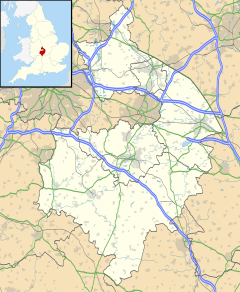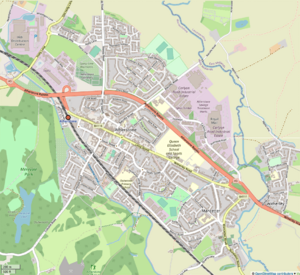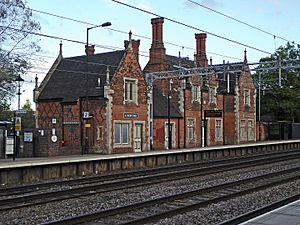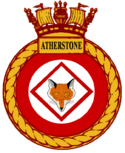Atherstone facts for kids
Quick facts for kids Atherstone |
|
|---|---|
 Atherstone Market Square, looking towards St Mary's Church |
|
| Population | 9,212 (parish 2021) 11,259 (built-up area 2021) |
| OS grid reference | SP3098 |
| District |
|
| Shire county | |
| Region | |
| Country | England |
| Sovereign state | United Kingdom |
| Post town | ATHERSTONE |
| Postcode district | CV9 |
| Dialling code | 01827 |
| Police | Warwickshire |
| Fire | Warwickshire |
| Ambulance | West Midlands |
| EU Parliament | West Midlands |
| UK Parliament |
|
| Website | www.atherstone-tc.gov.uk |
Atherstone is a lively market town in Warwickshire, England. It is located in the northern part of the county. The town sits on the A5 national route. It is also very close to the border with Leicestershire. The River Anker forms this border. Atherstone is found between the towns of Tamworth and Nuneaton. It is the main administrative center for the North Warwickshire area. The local council offices are in the town.
Atherstone has a special local tradition. Every year, on Shrove Tuesday, a unique Ball Game is played in the streets. This game has been played for over 800 years, since 1199!
In 2021, the population of Atherstone parish was 9,212 people. If you include the nearby village of Mancetter, the population of the larger built-up area was 11,259.
Contents
Atherstone's Past
Atherstone has a very long and interesting history. It goes all the way back to Roman times.
Roman Times
The famous Roman road, the Watling Street, passed right through where Atherstone is today. This road later became part of the A5. An important Roman settlement called Manduessedum was located near modern-day Atherstone, in Mancetter.
Many historians believe that the final battle of the rebel Queen Boudica against the Romans happened near Manduessedum. This battle took place around AD 60. Famous archaeologist Graham Webster thought this was the most likely spot. However, there is no strong proof yet to confirm this idea.
Medieval Period
The Domesday Book of 1086 mentions Atherstone, calling it Aderestone. At that time, it was owned by Countess Godiva. The name probably comes from Old English, meaning 'Aedelred's farmstead' or 'town'.
After the Norman Conquest, Atherstone was given to Hugh Lupus, Earl of Chester. He then gave it to the monks of Bec Abbey in Normandy. In 1246, these monks received a special permission from King Henry III. This allowed them to hold a weekly market in Atherstone. This event turned the settlement into a busy market town.
In the 14th century, the town grew even more. Ralph Basset started a monastery of Augustinian friars here in 1375. However, it never became very large or important.
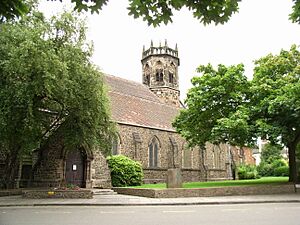
The old St Mary's Church in Atherstone dates back to the early 12th century. The chapel was given to Henry Cartwright in 1542. It was then left empty and uncared for until 1692. After that, it started to be used again. Its square tower was rebuilt in the popular "Gothic" style in 1782. It was redesigned again in 1849.
Battle of Bosworth Connection
On August 21, 1485, Henry Tudor and his army of up to 11,000 soldiers stayed in Atherstone. This was the day before the famous Battle of Bosworth. It is said that Tudor stayed at the Three Tuns Inn on Long Street. His troops camped in a field north of the church.
During his stay, Tudor secretly met with powerful noblemen, Thomas Stanley and his brother William Stanley. They promised to support Tudor. This support was very important in the battle that followed.
The battle happened about 8 miles (13 km) away, near Market Bosworth in Leicestershire. Tudor's forces defeated King Richard III. This allowed Tudor to become King Henry VII and start the Tudor dynasty.
Some people believe the battle actually took place in the fields of Merevale, above Atherstone. However, this idea is not widely accepted. The main reason for this theory is that Atherstone received money after the battle, not Market Bosworth.
Today, the battle site is known to be around the 'Fenn Lanes'. These lanes run from near Atherstone to Sutton Cheney. The site is northwest of Stoke Golding. It is roughly halfway between Atherstone and Market Bosworth.
Tudor Period Growth
During the Tudor period, Atherstone was a busy place for weaving and making cloth. The town was built as a long 'ribbon development' along Watling Street. This good location helped it grow as a market town.
Even though it was still an agricultural settlement, efforts were made to attract merchants and traders. This was done by creating burgage plots. These were special land agreements that gave traders certain benefits. A old document from King's College mentions creating nine new burgage strips.
By the late Tudor period, Atherstone was known for working with leather, making cloth, metalwork, and brewing. Local sheep and cattle farmers provided wool and leather. This supplied local tanners and shoemakers. This shoe-making industry continued until the 1970s.
Metalworkers, locksmiths, and nailers used local coal for their furnaces. Ale makers supplied drinks on market days. Old records from 16th century Mancetter show what Atherstone's merchants were like. They show Atherstone as a typical Midlands market town. It made good use of its location and farming surroundings.
From 17th Century to Today

Some people thought Atherstone became less important in the 18th century. However, this idea has been questioned. In the 1750s, Atherstone was still a lively place. It had a book club and a bowling-green. Important people, like Sir Roger Newdigate, often visited for leisure.
The Coventry Canal reached Atherstone in 1769. Railways arrived in 1847 with the opening of the Trent Valley Railway. Atherstone got its own station on this line. These transport links helped the town become more industrial.
Atherstone was once an important town for making hats. It became famous for its felt hat industry. This industry started in the 17th century. At its peak in the early 1900s, seven companies employed 3,000 people.
However, cheap imports and fewer people wearing hats caused the industry to decline. By the 1970s, only three companies remained. The making of felt hats in Atherstone stopped completely in 1999. This was when the Wilson & Stafford factory closed. In 2022, the last hat manufacturing site was planned for demolition.
How Atherstone is Governed
Atherstone is part of the North Warwickshire and Bedworth area for Parliament. The current MP for this area is Rachel Taylor from the Labour Party.
The main local government is North Warwickshire Borough Council. Since May 2023, no single party has full control of this council. Atherstone also has its own Town Council. Atherstone Town Council has 15 councillors who represent three different areas.
Where Atherstone is Located
Atherstone is located about 6 miles (10 km) northwest of Nuneaton. It is 7 miles (11 km) southeast of Tamworth. Coventry is 13 miles (21 km) to the north. Birmingham is 16 miles (26 km) northeast. Leicester is 17 miles (27 km) east-southeast.
The village of Mancetter has grown to join Atherstone to the southeast. However, it is still a separate local area. Atherstone is close to the River Anker. This river forms the border between Warwickshire and Leicestershire. The village of Witherley is on the other side of the river in Leicestershire.
Other nearby villages include Sheepy Magna, Ratcliffe Culey, and Fenny Drayton. Also close by are Grendon, Dordon, Baxterley, Baddesley Ensor, and Hartshill. The town of Coleshill is to the southeast.
The A5 road used to go through the town center. But a new dual carriageway bypass was opened in 1963. This helps traffic flow better around the town.
Atherstone is one of the towns closest to the geographic center of England. Since 2002, this center has been recognized as being at Lindley Hall Farm. This farm is about 3 miles (5 km) east of Atherstone. It is just across the county border in Leicestershire.
Atherstone's Economy
Atherstone was once famous for making hats. Because of its central location in the UK, Atherstone's economy has grown quickly since the 1980s. Several big companies have set up their main offices or national distribution centers here. These include 3M (in 1964), TNT (in 1987), and Aldi (in the 1990s).
The British Home Stores warehouse was in the town for 40 years. It closed in August 2016. Now, Royal Mail uses it as a regional sorting office.
Getting Around Atherstone
Atherstone is on the main A5 national route. It is also close to the M42 motorway.
The Coventry Canal runs through the town with a series of eleven locks. The West Coast Main Line railway also passes through Atherstone. The town has its own railway station on this line. There is an hourly train service seven days a week. Trains go to both London and Crewe via Stafford. This improved service started in 2008. It is much better than two decades earlier, when there were only five trains a day.
The historic station building was built in 1847. It was almost torn down in the early 1980s. But a local group helped get it protected. The building celebrated its 150th anniversary in 1997. The renovation work even won an award. Since 2008, a local veterinary practice has used the railway station building.
Local Media
Local news and TV shows for Atherstone are provided by BBC West Midlands and ITV Central. TV signals come from the Sutton Coldfield TV transmitter.
Local radio stations include BBC CWR and BBC Radio Leicester. You can also listen to Capital Midlands, Hits Radio Coventry & Warwickshire, and Greatest Hits Radio Midlands.
The town is served by local newspapers. These are the Atherstone Herald and the Tamworth Herald.
Fun and Recreation
The main football team in Atherstone is Atherstone Town. They are known as 'the Adders'. This nickname comes from the idea that Atherstone's name might be a changed version of "Adders – stone". Their home ground is on Sheepy Road.
Atherstone's team started as Atherstone Town Football Club in 1887. It stopped playing in 1979. From 1979 to 2003, the team was called Atherstone United Football Club. It stopped playing again in 2003. The team then went back to its old name, Atherstone Town Football Club.
In October 2013, the club was in the national news. During an FA Cup match, some crowd trouble happened. Since then, the club has worked hard to be a family and community-focused club.
The rugby union team is Atherstone Rugby Football Club. They play in the Warwickshire Two League. Their ground is on Ratcliffe Road. This same ground is shared by Atherstone Town Cricket Club and Atherstone Rangers Junior Football Club. It is also the home of Atherstone Adders Hockey Club. They play at the nearby Queen Elizabeth Academy.
The Atherstone Leisure Complex is at the north end of Long Street. It has a swimming pool and a gym. The Atherstone Memorial Hall is also part of this complex.
The Shrovetide Ball Game
A very old tradition in Atherstone is the annual Shrove Tuesday Ball Game. It is played in the streets with huge crowds. The game celebrated its 800th anniversary in 1999.
The game is a free-for-all. It is played along Watling Street, which is the main street of Atherstone. The ball is decorated with red, white, and blue ribbons. People who get a ribbon can exchange it for money. The ball is made of thick leather, so it is too heavy to kick far.
The game starts at 3:00 pm. The ball is thrown from the balcony of the local Conservative Club. Before 2019, it was thrown from the Barclays Bank building. The game continues until about 5:00 pm. However, the ball can be deflated or hidden after 4:30 pm.
There are no teams and no goals. In the past, the game was played between a team from Warwickshire and one from Leicestershire. There is only one main rule: players are not allowed to kill one another. Whoever holds onto the ball at the end of the game wins. They also get to keep the ball.
The game is managed by "marshalls." Some of them are past winners. Police are present, but they let the game continue for the two hours it is played. It is said that many old disagreements are settled on Ball Game day. This Shrove Tuesday ball game has been held every year since the early 12th century. It is one of Atherstone's most famous traditions. The 2019 game was noted for being very rough. However, event organizers said this was "nothing new."
The game is thought to have started during the reign of King John. It was a "Match of Gold" played between the "Warwickshire Lads and the Leicestershire Lads."
A new ball is specially made each year. A famous sports person or celebrity usually throws it out to start the game. Shop windows are boarded up, and traffic is rerouted during the afternoon. Hundreds of people take part in the game.
Atherstone has strong connections to the Royal Navy. Three Royal Navy ships have been named HMS Atherstone after the town. These ships were launched in 1916, 1939, and most recently, 1985.
Schools in Atherstone
Primary schools in Atherstone include Outwoods Primary School, Racemeadow Primary Academy, and St Benedict's RC Primary Academy.
The Queen Elizabeth Academy is the state secondary school in the town.
Famous People from Atherstone
- Obadiah Grew (1607–1689) – A nonconformist minister.
- Abel Roper (1665–1726) – A journalist who wrote for the Tory party.
- William Stratford Dugdale (1800–1871) – A British Tory politician and MP.
- William Yolland (1810–1885) – A military surveyor, astronomer, and Britain's Chief Inspector of Railways.
- Prof Herbert R. Spencer (1860–1941) – A professor who specialized in childbirth.
- Sir John Bretland Farmer (1865–1944) – A British botanist.
- Rhoda Sutherland (1907–1989) – An academic who studied French language.
- Mary Fox (1922–2005) – An artist.
- Bill Olner (1942–2020) – A British Labour Party politician, MP for Nuneaton from 1992–2010.
- Leigh Lawson (born 1945) – A British film and stage actor, director, and writer.
- Andy Green (born 1962) – A British RAF fighter pilot and holder of the World Land Speed Record.
Sports Personalities
- Charlie Wilson (1895–1971) – An English footballer who played over 150 games for Stoke City.
- Arthur Johnson (1903–1987) – An English professional footballer.
- Jack Barnes (1908–2008) – An English professional footballer, also played for Atherstone Town F.C..
- Bernard Hunt (1930–2013) – An English professional golfer.
- Johnny Schofield (1931–2006) – An English footballer who played as goalkeeper.
- Frank Upton (1934–2011) – An English professional football player and manager.
- Les Green (1941–2012) – An English footballer and manager.
- Paul Broadhurst (born 1965) – An English professional golfer.
- Steve Webster (born 1975) – An English professional golfer.
See also
 In Spanish: Atherstone para niños
In Spanish: Atherstone para niños


